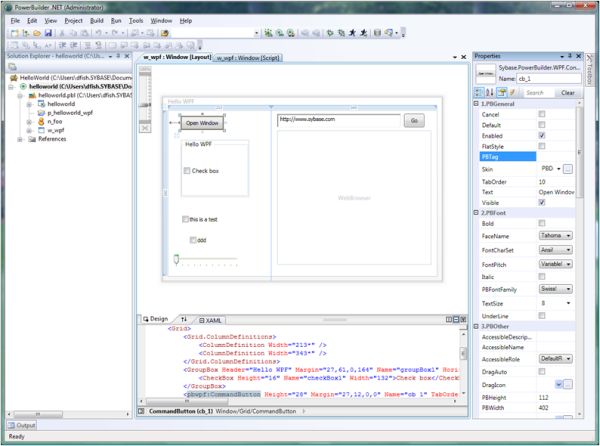First PowerBuilder 12 public beta adds Visual Studio IDE, fully embraces .NET
 Win32 is, to this day, the continually evolving basic API of Windows, keeping the "32" even in 64-bit systems. It remains in place to support what Microsoft and Sybase both call "legacy" apps, even though in Sybase's case, PowerBuilder is a substantial part of this legacy. With PB 12's embrace of .NET, for the first time, it moves toward full adoption of Windows Presentation Foundation, the graphical system that was created for Windows Vista, and rolled out during the Windows XP SP2 development cycle. Now, PB 12's new DataWindow component -- still at the heart of Sybase's value proposition -- will be geared to utilize WPF; and migration wizards in place for PB 12 will guide developers in moving legacy Win32 DataWindow apps to PB 12-era WPF apps.
Win32 is, to this day, the continually evolving basic API of Windows, keeping the "32" even in 64-bit systems. It remains in place to support what Microsoft and Sybase both call "legacy" apps, even though in Sybase's case, PowerBuilder is a substantial part of this legacy. With PB 12's embrace of .NET, for the first time, it moves toward full adoption of Windows Presentation Foundation, the graphical system that was created for Windows Vista, and rolled out during the Windows XP SP2 development cycle. Now, PB 12's new DataWindow component -- still at the heart of Sybase's value proposition -- will be geared to utilize WPF; and migration wizards in place for PB 12 will guide developers in moving legacy Win32 DataWindow apps to PB 12-era WPF apps.
"In PowerBuilder 12, when you write an application under the new .NET-based IDE, it'll be completely managed code when you deploy it. And the last huge piece of code that we had to rewrite and make managed was the DataWindow," remarked Sybase's PB product manager, Sue Dunnell. "As you can imagine, it's almost 20 years old itself, and it was a huge effort to rewrite. But that has been completely rewritten in C# -- which doesn't really matter to the end user because it's a component of PowerBuilder. But it natively supports WPF, and it provides a lot of rich functionality for a user experience that is much nicer than what PowerBuilder developers are used to providing for their customers. WPF is all about the richness of the user experience."
Once veteran PB developers have made the switch, there will be an entirely new world of programming for them to learn. For instance, WPF is also all about XAML, Microsoft's layout language for on-screen controls; and PB 12 is embracing XAML as well. In so doing, PB casts aside its reliance upon procedural programming for its complete architecture -- specifically, using statements and commands to instantiate and activate each and every visual object. In its place is the declarative programming model with which Web programmers are already very familiar -- essentially charting controls on paper and declaring, "Here they are."

No longer will you need seven or so unrelated function calls, Dunnell remarked, to invoke a command button. And that fact alone could foster a situation Sybase hasn't seen in quite some time: an influx of curious new PB developers.
"Back in PowerBuilder's heyday, we were really competing with Visual Basic. That was not really as rich a language -- they didn't have inheritance for quite some time. PowerBuilder was king, and we have such a huge, diverse base that it can be kind of frustrating sometimes, because some segments of our base really want the ability to do much more complex things, and they want direct access to the .NET Framework; and then other people are like, 'What is this XAML?' They can't keep up with this technology."
While PowerBuilder stuck to one thing, regardless of the whims of progress, Sybase's Sue Dunnell admitted, Visual Basic evolved into a nebulous mass with which Sybase simply could not compete. So it chose its next moves carefully, so as to avoid being characterized as having been assimilated by VS: "I think there has been a significant shift [in] Microsoft's place in the market and ours, and the creation of Visual Studio from Visual Basic. As a competitor, Visual Basic was really not something you would use for enterprise-class applications. Having Visual Studio be this enormous, end-to-end development environment is a little bit different. I still don't want to make PowerBuilder a plug-in to Visual Studio because I think that diminishes our presence. It's not a plug-in-able tool; it's too big, and too much of its own thing."
Sybase did decide at one point to make just the DataWindow a Visual Studio plug-in, to test the waters for the roles it could potentially play in contributing to an environment that Microsoft now clearly owned. "We had customers moving to Visual Studio," she recalled. "This allowed them to continue using PowerBuilder and leverage the code that they had written, and it also exposed Microsoft developers to the DataWindow."
Now that Sybase has begun the process of moving the base of developers it's nurtured to a realm established by Microsoft, will there be a point in time in which the company would consider shutting the door completely on its old environment, on its Win32 world -- a stick to go along with the carrot in moving the cattle train forward? As Sue Dunnell responded, "I think so, but I don't think that's any time in the foreseeable future, because I think we need to follow Microsoft's lead in that regard. And we've got just so many customers who still have, and still maintain, Win32-based applications. We can't even count the number of users we have, because we only track active users in our system who have current, in-market licenses, and maybe one or two versions before. But there are countless customers whom we speak to several times per month who have applications running on much, much older versions...and they run. They make enhancements, and they work, and the only time they really need to upgrade is when they're moving to a different operating system.
"So from what I've read," she continued, "Microsoft doesn't have any [end-of-life] date for the Win32 platform, but I think it's going to be a significant amount of time, and we're going to follow suit as well. Certainly if we saw something like a majority of our users moving to WPF within PowerBuilder...perhaps we would consider doing it earlier, but I think it would have to be a pretty significant number of customers."
Sybase is signing up users for Beta 1 now; and the company is planning to hold a TechWave Symposium in Washington, DC from August 26 - 27, where its engineers plan to discuss the beta of PB 12 in greater detail.